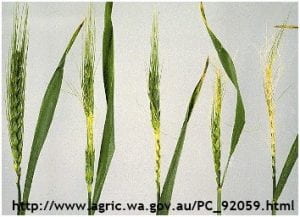Nathan Kleczewski, Extension Specialist – Plant Pathology; nkleczew@udel.edu
Sharp Eyespot, Fusarium Head Blight, and Frost Damage
Over the past week we have had a few reports of bleached heads or kernels on wheat and barley. In these cases the causative agents were Fusarium head blight, sharp eyespot, or frost damage. Although several other biotic and abiotic factors can result in bleached heads, I will go over a few key characteristics that you can use to determine if one of the aforementioned agents may be the cause of bleached heads in your barley and wheat.
Sharp Eyespot
Sharp eyespot is often observed at the base of the plant, where leaf sheaths develop circular or “cat eyed” lesions with a dark brown border. The affected tissues often rot, which results in the presence of a hole within the lesion. Culms develop similar lesions as well (Figure 1), which can be present several inches above the soil line. Often plants will survive to maturity unless infections are severe.
Fusarium Head Blight
Head blight is best recognized on heads where one or more spikelets appear prematurely bleached. Entire heads can be affected. Infected heads may have a pinkish color due to infection by Fusarium. If examined closely, pink or orange masses of spores may be visible on infected spikelets. Infected kernels may appear shriveled or discolored.
Frost Damage
Plants with frost damage tend to appear tip-blighted or bleached. Frost damaged heads can be deformed with bands of sterile florets (Figure 2). Some cultivars present blue-grey streaks on glumes. Often, affected heads develop a darkened appearance due to infection by secondary organisms. Frost can also cause characteristic white ring symptoms on the stem below the head and can blister, crack, and shrivel stems.
 Figure 1. Characteristic sharp eyespot lesions on a wheat stem. Photo by N. Kleczewski 2013
Figure 1. Characteristic sharp eyespot lesions on a wheat stem. Photo by N. Kleczewski 2013
 Figure 2. Wheat showing symptoms of frost damage.
Figure 2. Wheat showing symptoms of frost damage.
Ultimately, determining the cause of bleached heads will require microscopic examination. If you have symptomatic heads and would like to know the cause, please send whole plant samples to the University of Delaware Plant Diagnostic Clinic located in 151 Townsend Hall, Newark, Delaware. Please be sure to provide as much information as possible, including variety, recent chemical sprays, and overall appearance of the symptoms in the field (patches, random, bands, etc.).
Bacterial Mosaic
We observed barley with a mottled appearance in a field in Sussex County. Plants appeared to be affected by virus. However, analysis of the tissue indicated the presence of Clavibacter michiganense subsp. tessellarius, which causes Bacterial Mosaic in wheat (http://amarillo.tamu.edu/files/2010/11/BacterialMosaic.pdf). Plants tested negative for major plant viruses such as Barley Yellow Dwarf Virus. Plants eventually outgrew the disease and to date, do not appear to have suffered any noticeable effects. This is not a very well-studied disease and we do not know if this bacterium was present in field residue or if it was transmitted through diseased seed. Regardless, it is not known to cause significant yield loss in small grains.
